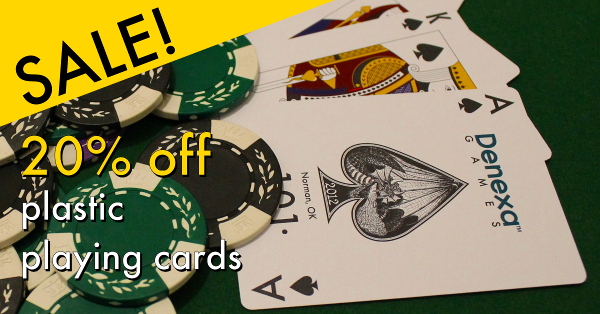Seven Twenty-Seven strategy
On Wednesday, we posted the rules of Seven Twenty-Seven. Today, we’re going to take a deeper look into the game and share some Seven Twenty-Seven strategy tips that will hopefully improve your skill at the game.
Probability
Seven Twenty-Seven is a game where it’s important to keep track of the probability of particular favorable or unfavorable outcomes. For example, you know that twelve of the fifty-two cards in the deck—about 23%—are face cards, and thus worth half a point. This can come in handy to keep in mind when attempting to determine what other players have, and whether drawing is or isn’t a good idea. For example, if a player is showing a 6 and is acting as though they are going low, it is far more likely that their count is actually 6½ rather than 7.
However, each draw is not an independent event; the probabilities change as the hand progresses. Keep an eye on other players’ hands—if you see lots of 10s and 9s already out, you’re less likely to bust. Likewise, watch out if a good chunk of the face cards have already come out! It means that the deck is composed of a greater percentage of higher cards.
The importance of being low
The winner of the low half of the pot is known fairly early on in most cases. Some players will be dealt hands with a count higher than 7 to begin with, and still others will find themselves overshooting 7 in an attempt to get closer to it. Usually, after one or two drawing rounds, there is only one player left standing under 7. This player knows they can’t lose, so they will be the one driving the betting by raising to the limit at every opportunity, and those going for high will have no choice but to call if they want the other half of the pot.
Therefore, you want to be that low player as often as possible. Obviously, if you are dealt a hand lower than seven, go for low. Even if you have a count of 8 or 9 (or 10½!), you may still be able to bluff low if the card that is showing is lower than 7. Wait a round or two before taking any cards, since standing, followed by betting, will be interpreted by your opponents as consistent with with going for low, and you should see some of your opponents fold naturally as they try to get nearer to 7 and overshooting or find that they have mid-range totals that aren’t good for either half of the pot. With aggressive betting, you may even be able to force any competitors for low, with low totals like one or two, to believe you have 7 or 6½, which will cause them to hit to get closer to 7 or simply fold. (This can be painful when they do end up with a total of 7.)
The most problematic thing that occurs when going low is when someone else is doing the same thing. Here, you will have to take into account their play history and probability to deduce what their count is. Obviously, if you are bluffing low, you should consider getting out of there, since attempting to force them out with aggressive betting can be expensive if it’s not successful. If you have a count less than 5 or so, consider taking a card to try to get closer to 7. If you overshoot, fold immediately—going for high with a starting total of 7½ puts you considerably behind the other players, and you will be milked for chips by your former low competitor the whole time.
If you find yourself as the only low player, take care in betting. Betting too high too early does nothing but scare players with marginal hands away. Keep the betting sane at first. Don’t break out the maximum bets until everyone is likely over 20 or so—at this point, players become attached to their hands since they are potentially one card away from 27.
Remember, the game ends when everyone declines to take a card. Also, you don’t have to have a count below 7 if you’re the only one going low. Therefore, if you’re the only low player, and the game shows signs of winding up, you can extend it a little, and get more chips in the pot, by taking a card. Players will virtually never fold at this point, because they are happy with their hands, so it’s essentially free money toward your half of the pot.
Folding vs. going high
If you’re showing a 7 through 10, you have no choice but to go high. But just because you have a count greater than 7 doesn’t mean you should go high. Folding early is an attractive option with a count of 8 through 14 or so. With counts this low, you will have to take several cards to get near 27 (think of all the face cards you might draw), and the low player will be betting the entire time, as well as any other players who get close to 27 before you.
15 through 17 is an excellent count for high, since a single 10 could put you at 27. Above 17 should obviously go for high, although the risk of busting is now present.
How close is close enough?
Unlike in Blackjack, where getting 17 (four away from 21) is considered good, you have to get considerably closer to 27 to win. Counts below 25 will seldom win without all other players busting. 25 is about the minimum you should stand on. If the hand is competitive, you may want to try to draw to 26 or greater. 26½ will rarely lose the hand.
Likewise, for low, if you have another player going low in the same hand, a count below about 5 or so may need to be hit. 6, 6½, and 7 are all very good totals to end on.
When you reach a total that is worth standing on, you should probably follow the low player’s lead and start trying to milk the players going for high that have not yet reached a total they’re satisfied with. They may fold, or even better, bust, and then you and the low player can split the proceeds.


